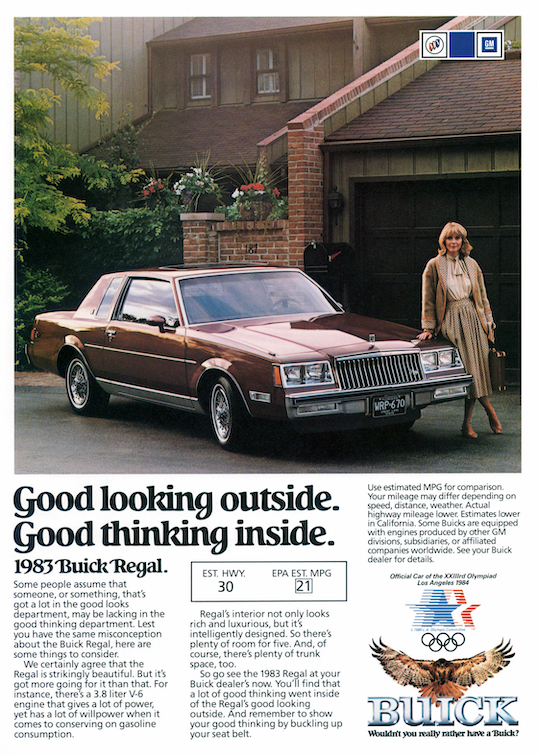
In an article posted a couple of years ago, Jalopnik blogger Elizabeth Blackstock discussed the lack of automotive advertising directed toward women. Although, as she noted, women compose over half of licensed drivers, 62 percent of all new cars sold in the US are purchased by women, and 85 percent of car buying decisions are made by women, advertising most often portrays the universal driver as male. When women are featured in car commercials, it is most often in the most stereotypical of roles. As Blackstock writes, “In the off chance that women are driving—sheʼs with her female friends staring at Ryan Reynolds, sheʼs picking the kids up from soccer practice, sheʼs by herself, or sheʼs marketing (dear God) car insurance. Youʼll be bombarded with those before you get one ad telling you to defy labels and pick the vehicle that truly suits you.”
The root of automakers’ failure to advertise to women is, plainly stated, masculinity. Car manufacturers are uneasy when automobiles become associated with femininity and the female car buyer. As I argue in my article about the chick car, women’s attraction to a particular automobile causes members of the male population to question the car’s technology. As the article states, “The assumption that women lack technical expertise creates a reverse kind of logic in the minds of many male consumers. They believe that since women cannot appreciate the finer technical characteristics of a car, such as power, handling, and performance, the cars women purchase must be technologically deficient. Women’s approval, in the minds of many men, leads to the devaluation of the car” (525). Consequently, the majority of cars that are, in fact, marketed to women are those of little interest to men.
This practice of selective car marketing is not a recent phenomenon. Over 35 years ago I worked in the creative department at a Detroit automotive advertising agency. My [female] partner and I were assigned the Buick Regal, which had been designated as the “woman’s car.” This classification was not due to its popularity among female consumers nor to any “female friendly” automotive features. Rather, it was because sales figures for the outdated Regal were dropping. Reconfiguring the Regal as the Buick offering especially appropriate for the woman driver was a dubious strategy to reinvigorate the brand. Traditionally, automakers have attempted to market unpopular cars to women when “authentic” automobile aficionados – male drivers – would no longer buy them.
Since the Regal held no apparent benefit for the woman driver, we decided to invent one. My partner and I put a clever spin on a tired female stereotype which suggests that attractiveness and brain power are mutually exclusive. Both the print ad and the television commercial feature a blonde, professional-looking woman posed next to a 1983 Regal. The print headline – “Good Looking Outside, Good Thinking Inside” – relies upon an often used and effective advertising strategy which calls upon a common positive attribute to link the product and the person who uses it. In this case, the line could be talking about the automobile or the woman standing beside it. The ad copy goes on to expand the misconception often applied to women – “that someone, or something, that’s got a lot in the good looks department, may be lacking in the good thinking department” – to include the smart and stylish Buick Regal. It mentions the beauty of the vehicle’s exterior, while also remarking on the vehicle’s powerful engine and intellectually designed interior, intimating that the woman who drives it is attractive, powerful, and intelligent as well.
While I don’t recall the exact words of the television commercial, a similar message was delivered by the same woman featured in the print ad. The technique called upon was what is known in the ad community as a “talking head” – the actor delivers the entire commercial speaking directly to the camera. The 30-second commercial ends on a somewhat prophetic note, as the spokeswoman turns toward the imagined audience and remarks, “Whoever’s in charge at Buick; she must really be something”. Who knew?
Although this campaign for the Buick Regal was created primarily to address an automotive sales issue, it did, at least, noted an automotive blogger, construct the female consumer as “classy, smart, and hard-working” (Kubin-Nicholson). The same could not be said for automotive advertising today. Women are stuck in minivans while the auto industry, ever fearful of offending the male customer, just keeps marketing cool cars to the guys.
As Blackstock notes, advertisements have an effect on the people who see them. As she writes, “If we’re bombarded with car commercials catered specifically to men […] we aren’t going to see women as interested in cars, so women won’t be as interested in cars, and, maybe more importantly, women aren’t even going to feel capable of understanding what makes a good car.” It’s a cycle that keeps repeating itself. Blackstock asks, “when do the girls get to take the wheel?” I enthusiastically echo her sentiments.
Blackstock, Elizabeth. “If Half the U.S. Drivers are Women, Why Aren’t Auto Manufacturers Doing a Better Job of Marketing to Them?” jalopnik.com 8Aug 2018.
Kubin-Nicholson (blog) “The Evolution of Car Ads.” Kubin.com 13 Apr 2013.
Lezotte, Chris. “The Evolution of the Chick Car: Or Which Came First the Chick or the Car?” The Journal of Popular Culture 45.3 (2012): 516-531.
Lezotte, Chris. “McCann & Me: One Woman’s Experience in Detroit Automotive Advertising.” Manuscript in Press, Automotive History Review.